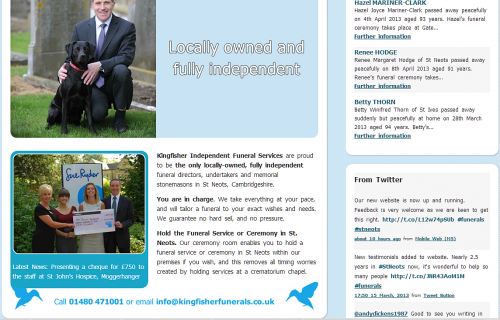Posted by Richard Rawlinson
A follow-up to Charles Cowling’s thirst-quenching piece about the need for independent undertakers to blow their trumpets louder to steal market share from the corporate chains, here.
It’s my hunch that some indies should stop perceiving themselves as niche, fringe and progressive, and instead project themselves as mainstream.
Why? There’s an abundance of eco-aware, price-conscious, non-religious, internet-savvy folk out there who see all their traits as the norm, unremarkable. They don’t book an atheist or new age civil celebrant to make a political stand against organised religion, but because their choice seems second nature. They don’t order a picnic hamper-style coffin and woodland burial ground as an eco-campaign against gratuitous embalming, but because it’s right for their personal needs. Ditto when they choose a budget funeral director to drive the body to the early-morning crem slot, and then deliver the ashes to the bereaved to do with them what they want, when they want.
People are used enough to variety in the market place not to feel radical when choosing a bespoke indie over a corporate brand. I became aware of this when recently furnishing a weekend escape in Clifton, Bristol. My first port of call was the internet as the Saturday shopping scrum is purgatory after a week in the office. Shopping from home, you can readily find the price and style you want with purchases delivered to your door. Sometimes, an online retailer has gained trust as a familiar high street brand, but other times you discover a hidden gem: I couldn’t resist a portrait made from driftwood by a guy in Cornwall—visitors gasp at its uncanny likeness to yours truly.
IKEA may be a success but there are those who feel nauseous at the inconvenience of shopping in an out-of-town warehouse, having to assemble purchases themselves and ending up with rickety tat. John Lewis succeeds among those content to pay a bit more for quality and service. Then again, I bypassed both when opting for a Georgian bureau, ordered online from an antique dealer as far afield as Yorkshire: the craftsmanship and romance of secret drawers couldn’t be matched by contemporary brands. Antiques also allow you to feel smug about recycling and supporting the little man.
The Cornwall artisan or antique dealer sniffed out online wouldn’t class themselves as ‘progressive’, with its undertones of challenging the status quo. Like Camra real ales, they’re in fact charmingly timeless, nostalgic even.
Despite commercial claims to the contrary, there’s little that’s new and much to be learned from past traditions. Live music at funerals is certainly not progressive. It’s superb that groups of musicians and singers (Malu Swayne’s No Sad Songs and Tim Clark’s Threnody are enriching ceremonies with music, but the concept is, thankfully, as old as the hills. Only it’s been lost in the modern age.
Crematoria were deemed genuinely progressive when they were introduced in the early 20th century. Today’s quest for more meaning and ritual is an acceptance that modernism in fact destroyed much that we cherish. It’s time to wind back the clock.
The Socialist Workers’ Party no doubt thought it was progressive to put on the cover of its newspaper a mock-up of Margaret Thatcher’s gravestone and the words ‘Rejoice’ . In fact they expose themselves as nasty dinosaurs while Maggie goes down in history as the Prime Minister who achieved more true progress than any other in recent times when it came to changing Britain for the better.
It would be progress if independent undertakers were perceived, not as fringe campaigners, but as mainstream companies that have rejected the profit-driven, merchandise-centric practices of the corporates. In grief in particular, people see financial manipulation as a betrayal of trust. The emphasis of any communications that reach out to the public should be on serving the emotional and spiritual needs of funeral planners. The indies should make a commodity out of traditional services and products and establish a new experienced-based value and pricing formula. Their strength should be to guide a family through the arrangement process and towards healing.
Customer expectations are low. Market opportunity is high for those who successfully become a part of the healing professions. Maggie would be so proud.

